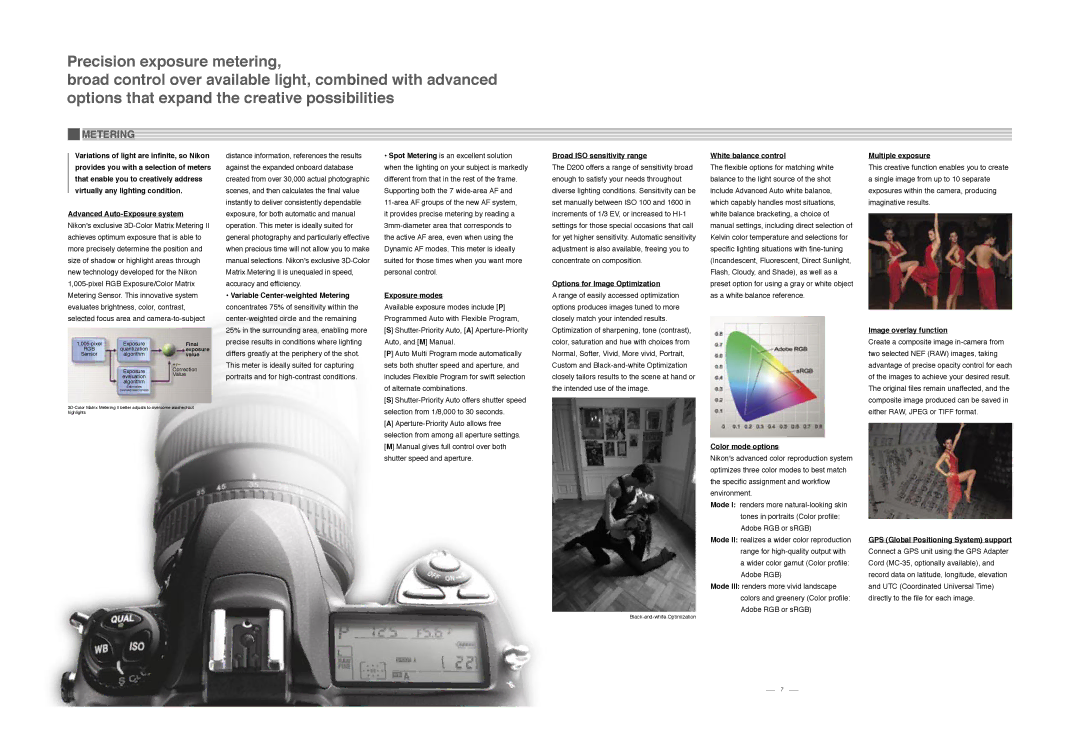 METERING
METERING
Variations of light are infinite, so Nikon provides you with a selection of meters that enable you to creatively address virtually any lighting condition.
Advanced Auto-Exposure system
Nikon’s exclusive 3D-Color Matrix Metering II achieves optimum exposure that is able to more precisely determine the position and size of shadow or highlight areas through new technology developed for the Nikon 1,005-pixel RGB Exposure/Color Matrix Metering Sensor. This innovative system evaluates brightness, color, contrast, selected focus area and camera-to-subject
1,005-pixel | Exposure | Final |
RGB | quantization | exposure |
Sensor | algorithm | value |
| Exposure | +/– |
| Correction |
| evaluation | Value |
| algorithm | |
| Estimates | |
| overexposed areas | |
3D-Color Matrix Metering II better adjusts to overcome washed-out highlights
distance information, references the results against the expanded onboard database created from over 30,000 actual photographic scenes, and then calculates the final value instantly to deliver consistently dependable exposure, for both automatic and manual operation. This meter is ideally suited for general photography and particularly effective when precious time will not allow you to make manual selections. Nikon’s exclusive 3D-Color Matrix Metering II is unequaled in speed, accuracy and efficiency.
•Variable Center-weighted Metering concentrates 75% of sensitivity within the center-weighted circle and the remaining 25% in the surrounding area, enabling more precise results in conditions where lighting differs greatly at the periphery of the shot. This meter is ideally suited for capturing portraits and for high-contrast conditions.
•Spot Metering is an excellent solution when the lighting on your subject is markedly different from that in the rest of the frame. Supporting both the 7 wide-area AF and
11-area AF groups of the new AF system, it provides precise metering by reading a 3mm-diameter area that corresponds to the active AF area, even when using the Dynamic AF modes. This meter is ideally suited for those times when you want more personal control.
Exposure modes
Available exposure modes include [P] Programmed Auto with Flexible Program, [S] Shutter-Priority Auto, [A] Aperture-Priority Auto, and [M] Manual.
[P] Auto Multi Program mode automatically sets both shutter speed and aperture, and includes Flexible Program for swift selection of alternate combinations.
[S] Shutter-Priority Auto offers shutter speed selection from 1/8,000 to 30 seconds.
[A] Aperture-Priority Auto allows free selection from among all aperture settings. [M] Manual gives full control over both shutter speed and aperture.
Broad ISO sensitivity range
The D200 offers a range of sensitivity broad enough to satisfy your needs throughout diverse lighting conditions. Sensitivity can be set manually between ISO 100 and 1600 in increments of 1/3 EV, or increased to HI-1 settings for those special occasions that call for yet higher sensitivity. Automatic sensitivity adjustment is also available, freeing you to concentrate on composition.
Options for Image Optimization
A range of easily accessed optimization options produces images tuned to more closely match your intended results.
Optimization of sharpening, tone (contrast), color, saturation and hue with choices from Normal, Softer, Vivid, More vivid, Portrait, Custom and Black-and-white Optimization closely tailors results to the scene at hand or the intended use of the image.
Black-and-white Optimization
White balance control
The flexible options for matching white balance to the light source of the shot include Advanced Auto white balance, which capably handles most situations, white balance bracketing, a choice of manual settings, including direct selection of Kelvin color temperature and selections for specific lighting situations with fine-tuning (Incandescent, Fluorescent, Direct Sunlight, Flash, Cloudy, and Shade), as well as a preset option for using a gray or white object as a white balance reference.
Color mode options
Nikon’s advanced color reproduction system optimizes three color modes to best match the specific assignment and workflow environment.
Mode I: renders more natural-looking skin tones in portraits (Color profile: Adobe RGB or sRGB)
Mode II: realizes a wider color reproduction range for high-quality output with a wider color gamut (Color profile: Adobe RGB)
Mode III: renders more vivid landscape colors and greenery (Color profile: Adobe RGB or sRGB)
Multiple exposure
This creative function enables you to create a single image from up to 10 separate exposures within the camera, producing imaginative results.
Image overlay function
Create a composite image in-camera from two selected NEF (RAW) images, taking advantage of precise opacity control for each of the images to achieve your desired result. The original files remain unaffected, and the composite image produced can be saved in either RAW, JPEG or TIFF format.
GPS (Global Positioning System) support Connect a GPS unit using the GPS Adapter Cord (MC-35, optionally available), and record data on latitude, longitude, elevation and UTC (Coordinated Universal Time) directly to the file for each image.

